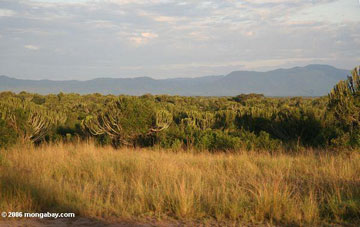Climate shift in East Africa due to geology, not global climate change
Climate shift in East Africa due to geology, not global climate change
Rhett A. Butler, mongabay.com
May 11, 2007
A past shift towards a drier climate in East Africa may be due to geological changes like the emergence of the Rift Valley, not global climate change suggests research published in the current issue of the journal Nature.
Dr. Bonnie Jacobs, Chair of Environmental Science Program at Southern Methodist University (SMU) in Dallas, Texas, reports that the rise of the high Ethiopian plateau may have caused dramatic shifts in the region’s vegetation.
Studying 12.6-million-year-old fossils in dry parts of Kenya’s Rift Valley and the northwestern Ethiopian plateau, Jacobs found remains of tropical plant species–evidence of the forests that once stretched across the now arid region. She says that while the valley is presently in a rain shadow, explaining its current dry state, it has been less clear how the Ethiopian plateau could have supported vegetation typically associated with wetter parts of Africa. Now, she reports, a new study provides a possible explanation.
 Vegetation just west of the Rift Valley. Photo by Rhett A. Butler The shift in East Africa’s climate is believed to be a key driver in human evolution, as closed forests gave way to savanna and open grasslands. |
“A recent modelling study (P. Sepulchre et al. Science 313, 1419-1423; 2006) surprised me by demonstrating that even moderate elevational changes could account for today’s drier climate,” she wrote. “It suggests that the high Ethiopian plateau acts as a barrier to incoming moist air masses, and need only have been 400-1,000 metres lower than today for the plants we found fossilized there to have flourished.”
She adds that while other factors likely played an important role in the disappearance of forest, but the modeling work sheds light on the possible influence of “palaeoaltitude as a significant driver of the region’s climate.”
“The tricky part for us as paleobotanists is to figure out just what variables were responsible for a climate 28 million years ago that was probably wetter, and certainly less seasonally dry, than the climate is today on the Ethiopian Plateau (where our fossil sites are located),” she told mongabay.com. “We had already considered that the continent was farther south (at a lower latitude) 28 million years ago than it is now, the plateau itself could have been at a different altitude (perhaps lower causing warmer temperatures), global climate could have been warmer, and the Tibetan Plateau could have been lower – diminishing the Asian monsoon. But, we never really considered the particular kinds of effects shown by the model.”
CITATION: Bonnie Jacobs (2007). Fossils from ancient forests in Africa provide a palaeobotanist with insight into past climates. NATURE MAY 10, 2007